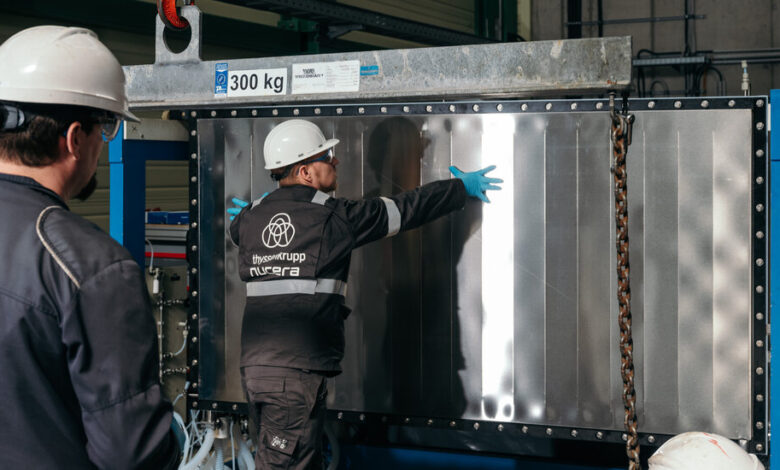Hydrogen Offers Germany a Chance to Take a Lead in Green Energy

In the city of Duisburg in Germany’s industrial heartland is a vast steel complex that is one of Europe’s largest polluters. But alongside the mill’s furnaces and smelters, technicians have developed a machine that could soon play a vital role in reducing greenhouse gas emissions.
By using electricity to split water into its two elements, the device, a test model called an electrolyzer, produces hydrogen, a carbon-free gas that could help power mills like the one in Duisburg. If adopted widely, the devices could help clean up heavy industry, such as steel-making, in Germany and elsewhere.
“We are maybe in one of those few very promising industries where Germany has a significant and very promising base,” said Werner Ponikwar, chief executive of ThyssenKrupp Nucera, which produces the electrolyzers. The company was spun off from ThyssenKrupp, a German steel giant, in 2023.
The Nucera project was backed by a German government fund worth 700 million euros, or $746 million. Overall, German state and federal governments have earmarked €13.2 billion for investment in about two dozen projects to develop hydrogen.
The concept of hydrogen as a renewable energy source has been around for years, but only within the past decade has the idea of its potential to replace fossil fuels to power heavy industry taken off, leading to increased investment and advances in the technology.
That support is beginning to pay off. The owners of some of the world’s most ambitious clean energy projects, including Shell, Europe’s largest energy company, and the government of Saudi Arabia, have ordered much larger versions of the two-megawatt electrolyzer in Duisburg, as they look toward a carbon-free industrial era.
Washington earmarked more funding as part of the incentives in President Biden’s Inflation Reduction Act, the 2022 law that is offering hundreds of billions of dollars for carbon-free, or green, technology. The Department of Energy awarded Nucera a $50 million grant last month to further develop production of gigawatt-scale electrolyzers for North America.
Such large subsidies reflect the recognition that the technology will not get off the ground without government support, said Christoph Noeres, head of green hydrogen at Nucera, pointing to the multibillion-dollar pledges for green steel and green hydrogen projects from Berlin to Washington.
“I think they understood that it must be now big scale,” he said.
Analysts point to the ability of hydrogen produced with renewable energy to slash carbon dioxide emissions from heavy industries, including steel-making and long-haul travel by air or sea.
“The only reason we should not believe in hydrogen is if we do not believe in decarbonization altogether,” said Bernd Heid, who heads the Platform for Climate Technologies at the consulting firm McKinsey & Company. “There are ups and downs and it’s going in waves, but I am confident that we are on a long steady path to decarbonization.”
Germany is working to radically reduce the amount of carbon dioxide it emits by 2045. That will mean not only shifting to low-carbon fuels like electricity for heating and transportation, but finding ways to slash emissions from the dirtiest industries, including steel, fertilizer and cement.
ThyssenKrupp plans to use hydrogen to eventually help reduce the 20 million tons of carbon dioxide that its steel mill in Duisburg pumps out each year, or about 2.5 percent of Germany’s overall emissions. The company, which traces its roots to the industrial revolution in the 19th century, recently found its existence threatened by competition from China and other factors undercutting its key businesses, including steel-making.
On April 11, ThyssenKrupp announced that it would reduce production capacity at the Duisburg plant, which employs some 13,000 people, by around 20 percent. The company cited high energy prices and the pressure to meet carbon neutrality among reasons for the reduction.
ThyssenKrupp’s foray into hydrogen through Nucera, of which it owns just over 50 percent, shows that seeds of economic growth for German industries may be in the rusting landscapes of industrial decay. Among ThyssenKrupp’s grab bag of businesses was a world-leading supplier of equipment for making chlorine, a chemical with many uses including in drinking water and swimming pools. As it turns out, new iterations of these machines can be used to make hydrogen.
As interest in using hydrogen as a clean fuel grew, ThyssenKrupp executives figured out that they could secure a place in the renewable energy business. “All those features that, I would say, our industry is striving for we have already in our pockets,” Mr. Ponikwar said.
Being linked to a well-known company that has helped build factories and other large facilities around the world has turned out to be a selling point for potential customers. When CF Industries, a large fertilizer maker, decided to invest in an electrolyzer to help make low-emissions ammonia at a plant in Donaldsonville, La., it was ThyssenKrupp’s industrial track record that led it to pick Nucera to supply a $100 million unit.
“We believed it provided the lowest risk from a technology standpoint and the highest performance and reliability,” said Tony Will, chief executive of CF Industries.
Similar attributes led H2 Green Steel, a start-up based in Stockholm, to pick ThyssenKrupp to supply what may be the largest electrolyzer in Europe for a plant in northern Sweden that will produce emissions-free steel. Very few potential suppliers “have the muscles” to meet the performance targets required, said Maria Persson Gulda, chief technology officer of H2 Green Steel.
Nucera has not entirely escaped the downturn in renewables, which has pounded the shares of other hydrogen-focused companies like ITM Power in Britain and Plug Power in the United States. The company’s shares, which were listed at €20 in July, have fallen to about €12.
With higher interest rates and inflation upending the economics of renewable energy projects, analysts have dialed back their forecasts for the adoption of hydrogen. “Everything is more expensive than originally thought,” said Hector Arreola, principal analyst for hydrogen at Wood Mackenzie, an energy consulting firm.
Nucera said in February that sales for the quarter ending on Dec. 31 rose 35 percent from a year earlier, to €208 million.
The boost came mainly from delivery of electrolyzers to Saudi Arabia, where the company is supplying what could be the world’s largest array of green hydrogen producers as part of an $8.4 billion project in the region of Neom, the ambitious city being built by Crown Prince Mohammed bin Salman. The Saudi government owns 6 percent of Nucera’s shares.
The economics of green hydrogen are largely determined by the price tag for the electrolyzers and the cost of the volumes of carbon-free electric power needed to run them. In an effort to retain energy leadership in the coming years, Saudi Arabia has big ambitions as a hydrogen exporter because it can produce cheap solar power in its vast deserts. H2 Green Steel has secured a low-cost contract for hydroelectric power, another green source.
Green hydrogen produced by electrolyzers tends be more expensive than so-called gray hydrogen, which relies on fossil fuels and produces emissions when used in industries like fertilizers and oil refining. An experimental hydrogen index compiled by the European Energy Exchange, a financial market, pegs green hydrogen at about eight times the cost of European natural gas futures.
Mr. Will of CF Industries said the key energy cost of making his green ammonia would be $600 a ton — six times as much as with gray hydrogen. He is lining up customers willing to pay a premium for a green product.
CF Industries said support for making hydrogen under the Biden administration’s Inflation Reduction Act could narrow much of the difference.
At the same time, existing industrial players seem likely to play a key role in shifting to cleaner processes using hydrogen and other alternatives.
“You need that skill set that Europe — and especially Germany — has developed over the past hundred years,” Mr. Heid said. “Industrial companies have the technology, and they have the skills to scale it up.”



